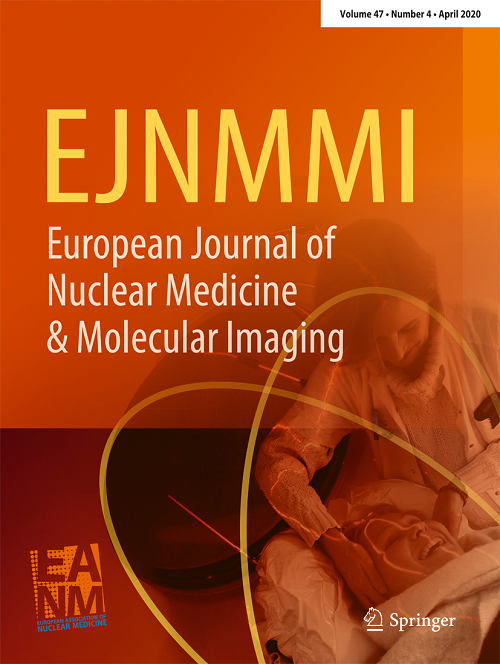全身[68 Ga]Ga- psma -11 PET/CT在前列腺癌中的临床应用:识别区域外骨转移并告知治疗策略。
IF 7.6
1区 医学
Q1 RADIOLOGY, NUCLEAR MEDICINE & MEDICAL IMAGING
European Journal of Nuclear Medicine and Molecular Imaging
Pub Date : 2025-10-06
DOI:10.1007/s00259-025-07581-9
引用次数: 0
摘要
背景与目的骨转移对前列腺癌患者的发病率和死亡率有显著影响,需要准确的检测和监测。虽然[68 Ga]Ga- psma -11 PET/CT成像与传统成像相比具有更高的灵敏度,但短轴向视场(SAFOV) PET/CT扫描仪获得的传统视场(CFOV;颅骨到股骨近端)可能低估了疾病的程度。本研究旨在利用全身[68 Ga]Ga- psma -11 PET/CT成像评估CFOV扫描范围外(股骨远端至近三分之一)骨转移的患病率和特征及其对前列腺癌患者肿瘤负荷、分期和后续治疗的影响。方法回顾性研究1211例前列腺癌患者行全身[68 Ga]Ga- psma -11 PET/CT显像。影像结果由三位核医学医师独立评估。阳性结果通过组织病理学、治疗反应、前列腺特异性抗原(PSA)变化或随访影像学证实。我们进一步描述了位于CFOV扫描范围之外的病变的临床和影像学特征。我们还评估了全身成像对肿瘤负荷生物标志物(PSMA-TV和TL-PSMA)和疾病分期的影响,并构建了一个nomogram来预测cfov外病变的风险。结果除骨转移外,全身[68 Ga]Ga- psma -11 PET/CT成像未发现CFOV扫描范围外的任何其他类型的病变。在1211例患者中,5.12%(62例)的骨转移灶在CFOV扫描范围外。多变量回归分析显示,去势抵抗性前列腺癌(CRPC)期患者,Gleason评分较高(≥8)和PSA水平较高(≥12.57 ng/mL)是CFOV扫描范围外骨转移的独立预测因子。我们开发了一种图来预测CFOV扫描范围外的骨转移,其中患者的疾病分期比Gleason评分和PSA水平更具预测价值。在62例病灶在CFOV扫描范围之外的患者中,肿瘤负荷指标显著增加(P < 0.001)。20例患者(占亚组的32.3%,占总队列的1.65%)改变了治疗计划。结论ssafov PET/CT扫描CFOV扫描范围可能低估骨转移的真实程度。使用全身PET/CT扫描仪进行全身扫描,发现5.12%的患者存在隐匿性骨转移,尤其是PSA、Gleason评分和CRPC分期较高的患者。这种扩展的观点显著影响肿瘤负荷的量化,导致疾病的晚期,并影响治疗计划。开发的图可以指导使用SAFOV PET/CT扫描仪中心的临床医生识别最受益于扩展视场成像的患者。本文章由计算机程序翻译,如有差异,请以英文原文为准。
The clinical utility of total-body [68 Ga]Ga-PSMA-11 PET/CT in prostate cancer: identifying extra-regional bone metastases and informing treatment strategies.
BACKGROUND AND PURPOSE
Bone metastasis significantly impacts morbidity and mortality in prostate cancer patients, necessitating accurate detection and monitoring. Although [68 Ga]Ga-PSMA-11 PET/CT imaging provides superior sensitivity compared with conventional imaging, the conventional field of view (CFOV; skull to proximal femur) obtained with short axial field of view (SAFOV) PET/CT scanners may underestimate the extent of disease. This study aimed to evaluate the prevalence and characteristics of bone metastases outside the CFOV scan range (distal to the proximal one-third of the femur) using total-body [68 Ga]Ga-PSMA-11 PET/CT imaging and its impact on tumor burden, staging and subsequent treatment in prostate cancer patients.
METHODS
This retrospective study included 1211 prostate cancer patients who underwent total-body [68 Ga]Ga-PSMA-11 PET/CT imaging. Imaging results were independently evaluated by three nuclear medicine physicians. Positive findings were validated through histopathology, treatment response, prostate-specific antigen (PSA) changes, or follow-up imaging. We further characterized the clinical and imaging characteristics of lesions located beyond the CFOV scan range. We also assessed the impact of total-body imaging on tumor burden biomarkers (PSMA-TV and TL-PSMA) and disease staging, and constructed a nomogram to predict the risk of extra-CFOV lesions.
RESULTS
Apart from bone metastases, total-body [68 Ga]Ga-PSMA-11 PET/CT imaging did not identify any other types of lesions outside the CFOV scan range. Among the 1211 patients, 5.12% (62 patients) had bone metastases outside the CFOV scan range. Multivariable regression analysis revealed that patients in the castration-resistant prostate cancer (CRPC) stage, with higher Gleason scores (≥ 8), and higher PSA levels (≥ 12.57 ng/mL) were independent predictors of bone metastases outside the CFOV scan range. We developed a nomogram to predict bone metastases outside the CFOV scan range, in which the patient's disease stage demonstrated greater predictive value than the Gleason score and PSA level. In the subset of 62 patients with lesions outside the CFOV scan range, tumor burden metrics were significantly increased (P < 0.001). Treatment plans were altered in 20 patients (32.3% of the subgroup; 1.65% of the total cohort).
CONCLUSIONS
SAFOV PET/CT scanners with CFOV scan range may underestimate the true extent of bone metastasis. Total-body scan range using total-body PET/CT scanners revealed occult bone metastases in 5.12% of patients, particularly in those with higher PSA, Gleason scores, and CRPC stage. This extended view significantly impacts tumor burden quantification, leads to disease upstaging, and influences treatment planning. The developed nomogram can guide clinicians at centers with SAFOV PET/CT scanners in identifying patients who would most benefit from extended field-of-view imaging.
求助全文
通过发布文献求助,成功后即可免费获取论文全文。
去求助
来源期刊
CiteScore
15.60
自引率
9.90%
发文量
392
审稿时长
3 months
期刊介绍:
The European Journal of Nuclear Medicine and Molecular Imaging serves as a platform for the exchange of clinical and scientific information within nuclear medicine and related professions. It welcomes international submissions from professionals involved in the functional, metabolic, and molecular investigation of diseases. The journal's coverage spans physics, dosimetry, radiation biology, radiochemistry, and pharmacy, providing high-quality peer review by experts in the field. Known for highly cited and downloaded articles, it ensures global visibility for research work and is part of the EJNMMI journal family.

 求助内容:
求助内容: 应助结果提醒方式:
应助结果提醒方式:


